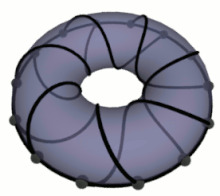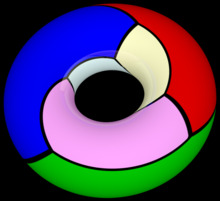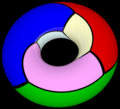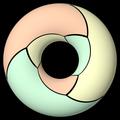

In mathematics, a toroidal graph is a graph that can be embedded on a torus. In other words, the graph's vertices can be placed on a torus such that no edges cross.
Examples
Any graph which can be embedded in a plane can also be embedded in a torus. A toroidal graph of genus 1 can be embedded in a torus but not in a plane. The Heawood graph, the complete graph K7 (and hence K5 and K6), the Petersen graph (and hence the complete bipartite graph K3,3, since the Petersen graph contains a subdivision of it), one of the Blanuša snarks,[1] and all Möbius ladders are toroidal. More generally, any graph with crossing number 1 is toroidal. Some graphs with greater crossing numbers are also toroidal: the Möbius–Kantor graph, for example, has crossing number 4 and is toroidal.[2]
Properties
Any toroidal graph has chromatic number at most 7.[3] The complete graph K7 provides an example of toroidal graph with chromatic number 7.[4]
Any triangle-free toroidal graph has chromatic number at most 4.[5]
By a result analogous to Fáry's theorem, any toroidal graph may be drawn with straight edges in a rectangle with periodic boundary conditions.[6] Furthermore, the analogue of Tutte's spring theorem applies in this case.[7] Toroidal graphs also have book embeddings with at most 7 pages.[8]
Obstructions
By the Robertson–Seymour theorem, there exists a finite set H of minimal non-toroidal graphs, such that a graph is toroidal if and only if it has no graph minor in H. That is, H forms the set of forbidden minors for the toroidal graphs. The complete set H is not known, but it has at least 17,523 graphs. Alternatively, there are at least 250,815 non-toroidal graphs that are minimal in the topological minor ordering. A graph is toroidal if and only if it has none of these graphs as a topological minor.[9]
Gallery
Two isomorphic Cayley graphs of the quaternion group.
Cayley graph of the quaternion group embedded in the torus.
Video of Cayley graph of the quaternion group embedded in the torus.
The Heawood graph and associated map embedded in the torus.
The Pappus graph and associated map embedded in the torus.
See also
- Planar graph
- Topological graph theory
- Császár polyhedron
Notes
References
- Chartrand, Gary; Zhang, Ping (2008), Chromatic graph theory, CRC Press, ISBN 978-1-58488-800-0.
- Endo, Toshiki (1997), "The pagenumber of toroidal graphs is at most seven", Discrete Mathematics, 175 (1–3): 87–96, doi:10.1016/S0012-365X(96)00144-6, MR 1475841.
- Gortler, Steven J.; Gotsman, Craig; Thurston, Dylan (2006), "Discrete one-forms on meshes and applications to 3D mesh parameterization" (PDF), Computer Aided Geometric Design, 23 (2): 83–112, doi:10.1016/j.cagd.2005.05.002, MR 2189438.
- Heawood, P. J. (1890), "Map colouring theorems", Quarterly J. Math. Oxford Ser., 24: 322–339.
- Kocay, W.; Neilson, D.; Szypowski, R. (2001), "Drawing graphs on the torus" (PDF), Ars Combinatoria, 59: 259–277, MR 1832459, archived from the original (PDF) on 2004-12-24, retrieved 2018-09-06.
- Kronk, Hudson V.; White, Arthur T. (1972), "A 4-color theorem for toroidal graphs", Proceedings of the American Mathematical Society, American Mathematical Society, 34 (1): 83–86, doi:10.2307/2037902, JSTOR 2037902, MR 0291019.
- Marušič, Dragan; Pisanski, Tomaž (2000), "The remarkable generalized Petersen graph G(8,3)", Math. Slovaca, 50: 117–121.
- Myrvold, Wendy; Woodcock, Jennifer (2018), "A large set of torus obstructions and how they were discovered", Electronic Journal of Combinatorics, 25 (1): P1.16
- Neufeld, Eugene; Myrvold, Wendy (1997), "Practical toroidality testing", Proceedings of the Eighth Annual ACM-SIAM Symposium on Discrete Algorithms, pp. 574–580.
- Orbanić, Alen; Pisanski, Tomaž; Randić, Milan; Servatius, Brigitte (2004), "Blanuša double", Math. Commun., 9 (1): 91–103.



